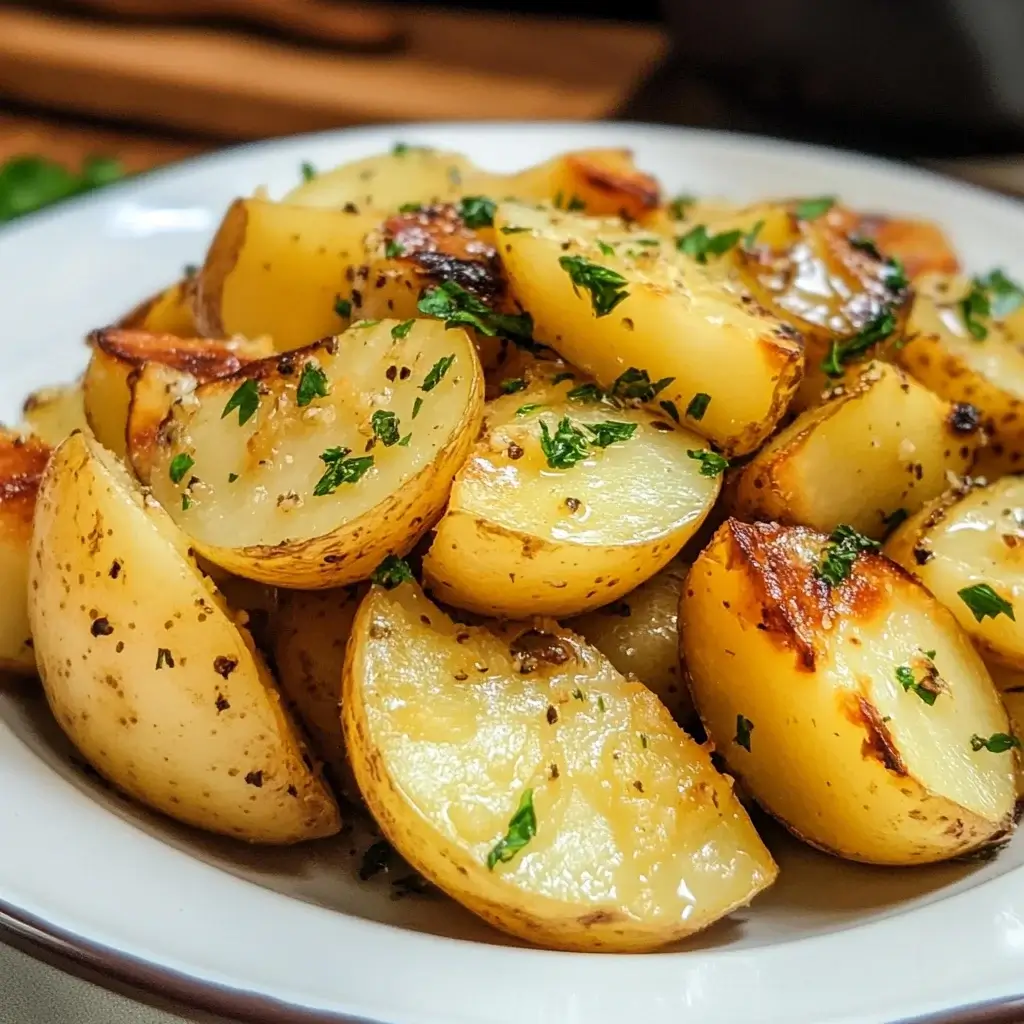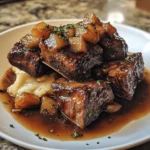There are certain dishes that just scream comfort, nostalgia, and pure, unadulterated flavour, and for me, Vesuvio Potatoes sit firmly in that category. The first time I encountered them was at a bustling, old-school Italian-American restaurant in Chicago, served alongside the eponymous Chicken Vesuvio. I was expecting standard roasted potatoes, but what arrived was something entirely different, something magical. These weren’t just roasted; they were bronzed wedges, impossibly crispy on the edges yet meltingly tender inside, swimming – absolutely swimming – in the most addictive, savoury sauce imaginable. A potent concoction of garlic, white wine, oregano, and rich chicken broth clung to every potato. The surprise addition of bright green peas scattered throughout cut through the richness perfectly. I practically needed a spoon (and extra bread!) to capture every last drop of that incredible sauce. Since then, I’ve dedicated myself to recreating that experience at home, and this recipe is the culmination of many delicious trials. It’s become a family legend; the request for “those amazing garlic potatoes with the sauce” comes up for Sunday dinners, special occasions, or frankly, anytime we need a serious dose of delicious comfort. They are, quite simply, potato perfection.
The Magic Behind Vesuvio Potatoes: Why This Recipe Works Wonders
Before we jump into the specific steps, let’s delve into what makes Vesuvio Potatoes so special and why this particular preparation yields such fantastic results. It’s a culinary equation where simple ingredients, treated correctly, produce something far greater than their individual parts.
- The Potato Choice – Russets Reign Supreme: While other potatoes can be used, Russets (or similar high-starch potatoes like Idaho) are traditionally preferred for Vesuvio. Their high starch content results in a wonderfully fluffy, absorbent interior that soaks up the flavourful sauce beautifully. Critically, they also develop exceptionally crispy, golden-brown edges when roasted correctly in hot oil, providing that essential textural contrast. Waxy potatoes, while delicious in other applications, tend to stay firmer and don’t achieve the same crispy-fluffy dynamic.
- The Roasting & Sauce Symbiosis: This isn’t just about roasting potatoes and then adding a sauce. The magic happens simultaneously. The potatoes begin by browning in hot oil, developing flavour and texture. Then, garlic is introduced, followed by white wine which deglazes the pan, lifting all those delicious browned bits (fond) off the bottom. Chicken broth and oregano are added, creating a flavourful braising liquid in the same pan. As the potatoes continue to roast in this liquid, they absorb its essence from the inside out, while the exposed tops continue to crisp. The liquid reduces slightly, concentrating its flavour and creating the signature Vesuvio sauce right alongside the potatoes.
- Garlic Powerhouse: Vesuvio potatoes are unapologetically garlicky, but it’s a mellowed, roasted garlic flavour, not harsh or raw. Adding the garlic after the potatoes have had a chance to brown prevents it from burning and becoming bitter. It infuses the oil and subsequently the wine-broth mixture, permeating every bite.
- Wine & Broth Foundation: The combination of dry white wine and chicken broth forms the backbone of the sauce. The wine adds acidity and complexity, cutting through the richness of the oil and potatoes. The chicken broth provides a savoury depth and body. Vegetable broth can be used for a vegetarian version, but classic Vesuvio relies on chicken broth.
- Oregano’s Herbal Heart: Dried oregano (often preferred over fresh in this robust, long-cooking dish) provides the characteristic Italian-American herbal note that ties everything together. It blooms in the hot oil and broth, releasing its pungent aroma and flavour.
- The Pea Surprise: The late addition of green peas might seem unusual, but it’s a traditional and brilliant touch. They add pops of sweetness and vibrant colour, offering a fresh counterpoint to the rich, savoury potatoes and sauce. Frozen peas work perfectly here.
- The Chicago Connection: Understanding its roots as a Chicago Italian-American staple adds to its charm. It’s a dish born from immigrant traditions adapting to local ingredients, resulting in hearty, flavourful, crowd-pleasing food. Making Vesuvio Potatoes connects you to that culinary heritage.
These elements combine to create a dish that is simultaneously rustic and sophisticated, incredibly flavourful, texturally diverse, and deeply comforting.
Ingredients You’ll Need for Authentic Vesuvio Potatoes
Gathering the right components is the first step towards achieving that perfect Vesuvio potato experience. Quality matters, but the ingredients themselves are straightforward pantry staples.
- Potatoes: 2.5 to 3 lbs (about 1.1 to 1.4 kg) Russet potatoes (approximately 4-5 medium-large potatoes). As mentioned, Russets are ideal for their texture.
- Olive Oil: 1/3 cup (80 ml) good quality extra virgin olive oil, or a light olive oil suitable for higher heat.
- Garlic: 6 to 8 large cloves garlic, peeled and smashed or roughly chopped. Don’t mince too finely, as it can burn easily.
- Dry White Wine: 1/2 cup (120 ml) dry white wine, such as Pinot Grigio, Sauvignon Blanc, or Chardonnay (unoaked is often best). Avoid sweet wines.
- Chicken Broth: 1 cup (240 ml) low-sodium chicken broth. Vegetable broth can be substituted for a vegetarian version.
- Dried Oregano: 1 tablespoon dried oregano. Crumble it slightly between your fingers as you add it to release more flavour.
- Salt: 1 1/4 teaspoons kosher salt or sea salt, divided (1 tsp for potatoes initially, 1/4 tsp later), or to taste.
- Black Pepper: 1/2 teaspoon freshly ground black pepper, or to taste.
- Frozen Peas: 1 cup (about 145g) frozen green peas. Do not thaw them beforehand.
- Optional: Fresh Parsley: 2 tablespoons chopped fresh flat-leaf parsley, for garnish.
A Note on Ingredient Selection:
- Potatoes: If you absolutely cannot find Russets, Yukon Golds can work, but they won’t be quite as fluffy inside or potentially as crisp outside. Cut them slightly larger. Ensure potatoes are scrubbed clean. Peeling is traditional and recommended for the best texture, but you can leave skins on if preferred (ensure they are very well scrubbed).
- Garlic: Use fresh garlic cloves. The pre-minced jarred variety doesn’t have the same robust flavour needed here. Smashing the cloves releases flavour without creating tiny bits that burn easily.
- Wine: If you don’t cook with wine, you can substitute an equal amount of extra chicken broth with a teaspoon of white wine vinegar or lemon juice added for acidity. However, the wine contributes significantly to the classic flavour profile.
- Oregano: Dried oregano is traditional and holds up well to the roasting time. If using fresh oregano, use about 3 tablespoons chopped and add it during the last 15-20 minutes of cooking.
Step-by-Step Instructions: Mastering Vesuvio Potatoes at Home
Follow these steps closely to recreate the authentic taste and texture of this beloved Chicago classic. Patience during the browning stage is key!
- Preheat and Prepare Pan: Position an oven rack in the lower third of the oven and preheat to 400°F (200°C). Choose a large, sturdy roasting pan or a heavy-duty, oven-safe skillet (at least 12-inch cast iron or stainless steel works well). The pan needs to be large enough to hold the potatoes in mostly a single layer without significant crowding. Add the 1/3 cup of olive oil to the pan and place it in the preheating oven for about 5-10 minutes to get the oil hot. Getting the oil hot before adding potatoes is crucial for achieving a good sear.
- Prepare the Potatoes: While the oven and pan are heating, peel the Russet potatoes. Cut them lengthwise into thick wedges, aiming for about 6-8 wedges per medium-large potato. Ensure the wedges are relatively uniform in size for even cooking. Rinse the cut potatoes under cold water briefly to remove excess surface starch, then – this is very important – pat them thoroughly dry with paper towels or a clean kitchen towel. Wet potatoes will steam and splatter in the hot oil, preventing browning.
- Brown the Potatoes (Stovetop or Oven Method):
- Oven Method (Simpler): Carefully remove the hot pan with the shimmering oil from the oven. Add the dried potato wedges to the hot oil carefully to avoid splashing. Toss them gently to coat with oil. Spread them out in a single layer as much as possible. Sprinkle evenly with 1 teaspoon of the kosher salt and the 1/2 teaspoon of black pepper. Return the pan to the hot oven and roast for 20 minutes.
- Stovetop Method (More Control, Better Browning): Alternatively, heat the oil in your oven-safe skillet over medium-high heat on the stovetop until shimmering. Carefully add the dried potato wedges in a single layer (work in batches if necessary to avoid crowding). Sear the potatoes, turning occasionally, until they are nicely browned on several sides, about 10-15 minutes total. Season with 1 teaspoon salt and 1/2 teaspoon pepper during this process. This method gives you more direct control over the initial browning but requires more attention. If using this method, proceed directly to step 4 on the stovetop.
- Add Aromatics:
- If Using Oven Method: After the initial 20 minutes of roasting, remove the pan from the oven. Scatter the smashed or chopped garlic cloves among the potatoes. Stir gently.
- If Using Stovetop Method: Push the browned potatoes to one side of the skillet. Add the garlic to the cleared space and sauté for about 30-60 seconds until fragrant. Be careful not to burn the garlic. Then, stir the garlic among the potatoes.
- Deglaze with Wine:
- If Using Oven Method: Return the pan to the oven for 1-2 minutes just to let the garlic become fragrant (watch carefully!). Remove from oven. Carefully pour the white wine over the potatoes. It will bubble and steam.
- If Using Stovetop Method: Pour the white wine directly into the hot skillet over the potatoes and garlic. Bring it to a simmer, scraping the bottom of the pan with a wooden spoon or spatula to loosen any delicious browned bits (fond). Let the wine bubble and reduce slightly for about 1-2 minutes, allowing the alcohol aroma to cook off.
- Add Broth and Oregano: Pour the chicken broth evenly over the potatoes. Sprinkle the dried oregano over everything, crumbling it between your fingers as you add it. Add the remaining 1/4 teaspoon of salt (or to taste). Gently stir everything together to combine. The liquid should come about halfway up the potatoes; it shouldn’t completely submerge them.
- Roast Until Tender: Transfer the pan (or return it, if using oven method) to the 400°F (200°C) oven. Roast for another 25-35 minutes, or until the potatoes are fork-tender and deeply golden brown, and the sauce has reduced slightly and thickened (it will still be quite liquid, which is correct). You can gently stir the potatoes once or twice during this time if desired, but it’s often unnecessary.
- Add Peas: Carefully remove the pan from the oven. Scatter the frozen peas directly over the potatoes and sauce (no need to thaw). Gently stir them into the hot liquid.
- Final Roast & Rest: Return the pan to the oven for just 5 more minutes, allowing the peas to heat through and become tender-crisp.
- Serve: Remove the Vesuvio Potatoes from the oven. Let them rest for 5-10 minutes – the sauce will continue to thicken slightly. If desired, garnish generously with chopped fresh parsley. Serve hot, making sure to spoon plenty of the incredible pan sauce over each serving.
Nutritional Information (Estimated)
Please note these values are approximate and can vary based on factors like potato size, oil absorption, and exact ingredient amounts. This estimation assumes the recipe serves 4-6 people.
- Servings: 4 (as a main side) to 6 (as part of a larger meal)
- Calories per serving (estimated): Approximately 400-550 kcal (based on 1/4th of the recipe)
Breakdown:
- Calories primarily come from the potatoes (carbohydrates) and olive oil (fats).
- Russet potatoes are a good source of potassium and Vitamin C.
- Olive oil provides heart-healthy monounsaturated fats.
- Garlic offers various beneficial compounds.
- Peas contribute some fiber, vitamins (like K and A), and a small amount of plant-based protein.
- The wine and broth contribute flavour but fewer calories.
While undeniably hearty and comforting, Vesuvio Potatoes offer more nutritional value than deep-fried potatoes, thanks to the roasting method and inclusion of vegetables and broth. They are best enjoyed as part of a balanced meal.
Preparation and Cooking Time
Knowing the time commitment helps you plan your dinner schedule.
- Preparation Time: Approximately 15-20 minutes (Peeling, cutting potatoes, smashing garlic, measuring ingredients).
- Cooking Time: Approximately 50 minutes to 1 hour 10 minutes (Includes initial browning/roasting, adding liquids, final roasting with peas).
- Total Time: Approximately 1 hour 5 minutes to 1 hour 30 minutes.
The process involves some active steps (prepping, browning/adding ingredients) and longer passive roasting times.
How to Serve Your Glorious Vesuvio Potatoes
These potatoes are stars in their own right but also play well with others. Here’s how to serve them:
- The Classic Pairing: Serve alongside Chicken Vesuvio. This is the quintessential Chicago pairing, where the chicken is often cooked in a similar garlic-wine-broth sauce. The potato sauce and chicken sauce mingle beautifully.
- With Other Roasted Meats: They are a fantastic side dish for:
- Roasted Pork Loin or Pork Chops
- Simple Roasted Chicken or Turkey Breast
- Roast Beef
- Italian Sausages (cooked alongside the potatoes during the last 20-25 minutes)
- As a Hearty Vegetarian Side (or Main):
- Ensure you use vegetable broth instead of chicken broth.
- Serve alongside grilled halloumi, baked tofu, or a hearty lentil loaf.
- Enjoy a larger portion as a satisfying vegetarian main course, perhaps with a simple green salad on the side.
- Essential Accompaniment: Always serve with crusty bread! You absolutely need something to sop up every last bit of that incredible Vesuvio sauce. Italian bread, ciabatta, or a good sourdough works perfectly.
- Family Style: Serve them directly from the roasting pan (if presentable) placed in the center of the table, allowing everyone to spoon potatoes and plenty of sauce onto their plates.
Pro Tips for Perfecting Vesuvio Potatoes
Elevate your potato game with these key tips:
- Dry Those Potatoes: It bears repeating: after rinsing the cut potatoes, pat them completely dry. Excess moisture is the enemy of crispiness. Water creates steam, which prevents the potatoes from browning properly in the hot oil. Take the extra minute for this step; it makes a huge difference.
- Hot Pan, Hot Oil: Preheating the roasting pan with the oil in the oven (or ensuring the oil is properly hot on the stovetop before adding potatoes) is crucial. Adding potatoes to lukewarm oil results in greasy, soggy potatoes rather than crispy ones. The initial high-heat sear sets the foundation for the texture.
- Don’t Crowd the Pan: Give your potatoes space! If they are packed too tightly in the roasting pan, they will steam instead of roast and brown. Use a large enough pan so they can sit in mostly a single layer. If necessary, use two pans rather than overcrowding one. Proper air circulation is key for crisp edges.
- Master the Sauce Consistency: The final sauce should be flavourful and plentiful but not watery thin or overly thick like gravy. It’s meant to be a robust pan sauce. If it seems too thin towards the end of cooking, you can roast for a few extra minutes. If it seems to be evaporating too quickly during roasting (ovens vary), you can add another splash of broth. Trust the process; the starch from the potatoes will slightly thicken the liquid as it cooks.
- Timing the Peas: Add the frozen peas only during the last 5 minutes of cooking. This is just enough time for them to heat through and become tender-crisp while retaining their bright green colour and fresh flavour. Adding them earlier will result in overcooked, mushy, army-green peas.
Frequently Asked Questions (FAQ) about Vesuvio Potatoes
Clearing up common queries about this delicious dish:
- Q: Can I use potatoes other than Russets?
- A: Yes, but with caveats. Russets are highly recommended for their fluffy interior and ability to get crisp. Yukon Golds are the next best alternative; they have a creamier texture and will still be delicious, though perhaps slightly less crispy. Waxy potatoes like red potatoes are generally not recommended as they hold their shape too firmly and don’t absorb the sauce or crisp up in the same way. If using alternatives, adjust cooking times as needed.
- Q: Can I make Vesuvio Potatoes ahead of time?
- A: While they are undeniably best served fresh from the oven to appreciate the crispy texture, you can make them ahead. Reheat them gently in a 350°F (175°C) oven on a baking sheet or in an oven-safe dish until warmed through (about 15-20 minutes). Avoid the microwave, as it will make them soft. The sauce might absorb more into the potatoes upon reheating, so they won’t be quite as saucy, but the flavour will still be excellent. You may need to add a splash of broth when reheating if they seem dry.
- Q: How do I make a vegetarian or vegan version of Vesuvio Potatoes?
- A: It’s very simple! To make it vegetarian, just substitute the chicken broth with a good quality vegetable broth. To make it vegan, use vegetable broth and ensure your chosen white wine is certified vegan (some wines use animal products in fining). All other core ingredients (potatoes, oil, garlic, oregano, peas, salt, pepper) are naturally vegan.
- Q: Why are they called “Vesuvio” Potatoes?
- A: They are named after the famous Italian volcano, Mount Vesuvius. The name is typically associated with the Chicago dish “Chicken Vesuvio,” which these potatoes traditionally accompany. While there’s no definitive origin story, theories suggest the name might evoke the robust, “explosive” flavour profile (especially the garlic and wine) or perhaps simply sounded appealingly Italian to the dish’s creators in the Italian-American community.
- Q: Can I add other vegetables or herbs?
- A: Yes, you can customize them, though the classic recipe is fantastic as is. Some compatible additions include:
- Onions: Add thick onion wedges along with the potatoes during the initial roasting.
- Bell Peppers: Add chunks of red or green bell pepper during the last 20-25 minutes of roasting.
- Rosemary: A sprig of fresh rosemary added along with the broth can complement the oregano nicely (remove the sprig before serving).
- Mushrooms: Add sliced mushrooms when you add the garlic.
- Keep additions minimal to let the core flavours shine through.
- A: Yes, you can customize them, though the classic recipe is fantastic as is. Some compatible additions include:
Vesuvio Potatoes are more than just a side dish; they are an event. With their crispy edges, tender insides, and unbelievably flavourful garlic-wine sauce studded with sweet peas, they are the epitome of Italian-American comfort food. Master this recipe, and you’ll have a guaranteed crowd-pleaser that brings a taste of Chicago culinary history right to your table. Don’t forget the crusty bread!
Print
Vesuvio Potatoes recipe
Ingredients
-
- Potatoes: 2.5 to 3 lbs (about 1.1 to 1.4 kg) Russet potatoes (approximately 4-5 medium-large potatoes). As mentioned, Russets are ideal for their texture.
-
- Olive Oil: 1/3 cup (80 ml) good quality extra virgin olive oil, or a light olive oil suitable for higher heat.
-
- Garlic: 6 to 8 large cloves garlic, peeled and smashed or roughly chopped. Don’t mince too finely, as it can burn easily.
-
- Dry White Wine: 1/2 cup (120 ml) dry white wine, such as Pinot Grigio, Sauvignon Blanc, or Chardonnay (unoaked is often best). Avoid sweet wines.
-
- Chicken Broth: 1 cup (240 ml) low-sodium chicken broth. Vegetable broth can be substituted for a vegetarian version.
-
- Dried Oregano: 1 tablespoon dried oregano. Crumble it slightly between your fingers as you add it to release more flavour.
-
- Salt: 1 1/4 teaspoons kosher salt or sea salt, divided (1 tsp for potatoes initially, 1/4 tsp later), or to taste.
-
- Black Pepper: 1/2 teaspoon freshly ground black pepper, or to taste.
-
- Frozen Peas: 1 cup (about 145g) frozen green peas. Do not thaw them beforehand.
-
- Optional: Fresh Parsley: 2 tablespoons chopped fresh flat-leaf parsley, for garnish.
A Note on Ingredient Selection:
-
- Potatoes: If you absolutely cannot find Russets, Yukon Golds can work, but they won’t be quite as fluffy inside or potentially as crisp outside. Cut them slightly larger. Ensure potatoes are scrubbed clean. Peeling is traditional and recommended for the best texture, but you can leave skins on if preferred (ensure they are very well scrubbed).
-
- Garlic: Use fresh garlic cloves. The pre-minced jarred variety doesn’t have the same robust flavour needed here. Smashing the cloves releases flavour without creating tiny bits that burn easily.
-
- Wine: If you don’t cook with wine, you can substitute an equal amount of extra chicken broth with a teaspoon of white wine vinegar or lemon juice added for acidity. However, the wine contributes significantly to the classic flavour profile.
-
- Oregano: Dried oregano is traditional and holds up well to the roasting time. If using fresh oregano, use about 3 tablespoons chopped and add it during the last 15-20 minutes of cooking.
Instructions
-
- Preheat and Prepare Pan: Position an oven rack in the lower third of the oven and preheat to 400°F (200°C). Choose a large, sturdy roasting pan or a heavy-duty, oven-safe skillet (at least 12-inch cast iron or stainless steel works well). The pan needs to be large enough to hold the potatoes in mostly a single layer without significant crowding. Add the 1/3 cup of olive oil to the pan and place it in the preheating oven for about 5-10 minutes to get the oil hot. Getting the oil hot before adding potatoes is crucial for achieving a good sear.
-
- Prepare the Potatoes: While the oven and pan are heating, peel the Russet potatoes. Cut them lengthwise into thick wedges, aiming for about 6-8 wedges per medium-large potato. Ensure the wedges are relatively uniform in size for even cooking. Rinse the cut potatoes under cold water briefly to remove excess surface starch, then – this is very important – pat them thoroughly dry with paper towels or a clean kitchen towel. Wet potatoes will steam and splatter in the hot oil, preventing browning.
-
- Brown the Potatoes (Stovetop or Oven Method):
-
- Oven Method (Simpler): Carefully remove the hot pan with the shimmering oil from the oven. Add the dried potato wedges to the hot oil carefully to avoid splashing. Toss them gently to coat with oil. Spread them out in a single layer as much as possible. Sprinkle evenly with 1 teaspoon of the kosher salt and the 1/2 teaspoon of black pepper. Return the pan to the hot oven and roast for 20 minutes.
-
- Stovetop Method (More Control, Better Browning): Alternatively, heat the oil in your oven-safe skillet over medium-high heat on the stovetop until shimmering. Carefully add the dried potato wedges in a single layer (work in batches if necessary to avoid crowding). Sear the potatoes, turning occasionally, until they are nicely browned on several sides, about 10-15 minutes total. Season with 1 teaspoon salt and 1/2 teaspoon pepper during this process. This method gives you more direct control over the initial browning but requires more attention. If using this method, proceed directly to step 4 on the stovetop.
-
- Brown the Potatoes (Stovetop or Oven Method):
-
- Add Aromatics:
-
- If Using Oven Method: After the initial 20 minutes of roasting, remove the pan from the oven. Scatter the smashed or chopped garlic cloves among the potatoes. Stir gently.
-
- If Using Stovetop Method: Push the browned potatoes to one side of the skillet. Add the garlic to the cleared space and sauté for about 30-60 seconds until fragrant. Be careful not to burn the garlic. Then, stir the garlic among the potatoes.
-
- Add Aromatics:
-
- Deglaze with Wine:
-
- If Using Oven Method: Return the pan to the oven for 1-2 minutes just to let the garlic become fragrant (watch carefully!). Remove from oven. Carefully pour the white wine over the potatoes. It will bubble and steam.
-
- If Using Stovetop Method: Pour the white wine directly into the hot skillet over the potatoes and garlic. Bring it to a simmer, scraping the bottom of the pan with a wooden spoon or spatula to loosen any delicious browned bits (fond). Let the wine bubble and reduce slightly for about 1-2 minutes, allowing the alcohol aroma to cook off.
-
- Deglaze with Wine:
-
- Add Broth and Oregano: Pour the chicken broth evenly over the potatoes. Sprinkle the dried oregano over everything, crumbling it between your fingers as you add it. Add the remaining 1/4 teaspoon of salt (or to taste). Gently stir everything together to combine. The liquid should come about halfway up the potatoes; it shouldn’t completely submerge them.
-
- Roast Until Tender: Transfer the pan (or return it, if using oven method) to the 400°F (200°C) oven. Roast for another 25-35 minutes, or until the potatoes are fork-tender and deeply golden brown, and the sauce has reduced slightly and thickened (it will still be quite liquid, which is correct). You can gently stir the potatoes once or twice during this time if desired, but it’s often unnecessary.
-
- Add Peas: Carefully remove the pan from the oven. Scatter the frozen peas directly over the potatoes and sauce (no need to thaw). Gently stir them into the hot liquid.
-
- Final Roast & Rest: Return the pan to the oven for just 5 more minutes, allowing the peas to heat through and become tender-crisp.
-
- Serve: Remove the Vesuvio Potatoes from the oven. Let them rest for 5-10 minutes – the sauce will continue to thicken slightly. If desired, garnish generously with chopped fresh parsley. Serve hot, making sure to spoon plenty of the incredible pan sauce over each serving.
Nutrition
- Serving Size: one normal portion
- Calories: 400-550





